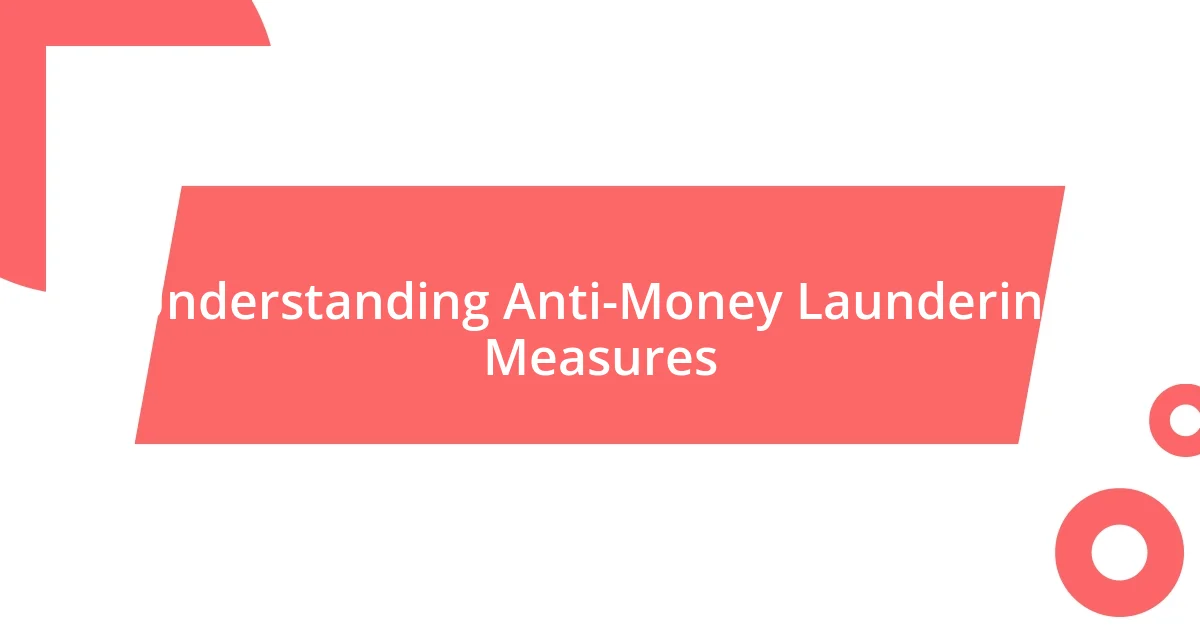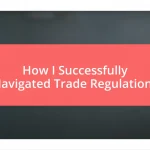Key takeaways:
- The Know Your Customer (KYC) process is essential for verifying client identities and preventing criminal activities, highlighting the balance between customer privacy and legal responsibility.
- Effective anti-money laundering (AML) compliance fosters trust among customers, protects the financial institution’s reputation, and contributes to overall financial security.
- Utilizing technology, such as AI and blockchain, enhances AML practices by identifying suspicious activities and providing clearer audit trails, thereby transforming compliance efforts.

Understanding Anti-Money Laundering Measures
Understanding anti-money laundering (AML) measures is critical in today’s financial landscape. I vividly recall my first exposure to the complexities of AML compliance during a training session. The instructor emphasized that money laundering can undermine the integrity of financial institutions, and at that moment, I realized how interconnected our global economy really is.
One key aspect of AML is the Know Your Customer (KYC) process. I often find myself reflecting on how much information is required just to open a bank account. It’s fascinating yet slightly unsettling, right? This process helps institutions verify the identities of their clients, ensuring that they aren’t inadvertently facilitating criminal activities. It made me appreciate the delicate balance between customer privacy and the responsibility of banks to uphold the law.
Another vital measure is transaction monitoring, which involves analyzing customer transactions for suspicious activities. I once witnessed a colleague flagging unusual patterns in a client’s account. That sense of vigilance is crucial; could you imagine being a part of a system that unknowingly allows illicit funds to circulate? Understanding these measures is not just about compliance–it’s about fostering trust and security in our financial systems.

Importance of Anti-Money Laundering Compliance
Anti-money laundering (AML) compliance is essential not just for legal reasons but also for protecting the financial system’s integrity. I remember when a regulatory change prompted my team to reassess our compliance strategies. The urgency was palpable, and I could feel the weight of responsibility on everyone’s shoulders. It became clear that neglecting these regulations could lead to severe reputational damage – something no institution can afford in today’s competitive market.
Effective AML measures also foster a sense of trust among customers and investors. In my experience, when customers know that their financial institution is committed to preventing money laundering, it boosts their confidence in engaging with the bank. I once had a conversation with a customer who expressed relief knowing our bank took these measures seriously. It’s a reminder that compliance is about more than just avoiding penalties; it’s about maintaining a relationship built on trust.
Lastly, robust AML compliance can significantly reduce the risk of financial crime within an organization. I’ve seen firsthand how implementing comprehensive compliance programs helps quickly identify and mitigate threats. This proactive approach not only protects the institution but also contributes to a healthier economy overall. I’m constantly reminded that when we actively participate in combating money laundering, we’re playing a vital role in safeguarding the financial ecosystem.
| Aspect | Importance |
|---|---|
| Legal Compliance | Ensures adherence to laws and regulations, avoiding legal penalties. |
| Customer Trust | Builds confidence among customers, encouraging loyalty and engagement. |
| Financial Security | Helps prevent financial crime, contributing to a stable economy. |

Identifying Money Laundering Red Flags
Identifying money laundering red flags is a task that requires both vigilance and intuition. In my experience, I’ve noticed that sometimes, the most telling signs are not overt but rather subtle shifts in behavior or transactions. For instance, I once had a client who consistently made large cash deposits just below the reporting threshold. While on the surface, it seemed innocuous, my gut instinct told me that there might be something more to it. Paying close attention to these nuances can make all the difference in flagging potential issues early.
Here are some common red flags to watch for:
- Unusual Transaction Patterns: Transactions that deviate from the client’s normal activity, such as large, unexpected transfers.
- Inconsistent Information: Discrepancies in the customer’s provided information, such as contradictory address or identification details.
- Complex Ownership Structures: A client who has a web of corporate entities that make it difficult to determine true ownership.
- Reluctance to Provide Information: A customer who is evasive or uncooperative when asked for details about their financial activities.
- Frequent Wire Transfers: Particularly to or from high-risk jurisdictions, which often indicate potential laundering activity.
Each of these flags serves as a crucial reminder that due diligence is not just a regulatory obligation; it’s a commitment to safeguarding the financial system. I often recall moments where my team decided to investigate unusual activities more deeply, only to uncover significant insights that enhanced our understanding of the client relationship and ultimately protected our institution from potential risk. It’s a constant balancing act between trust and caution—one that I feel passionate about navigating responsibly.

Implementing Effective AML Training
Implementing effective AML training is essential for fostering a culture of compliance within any financial institution. I still remember the group training session we hosted after a recent regulatory update; the buzz in the room was palpable. It was evident that everyone understood the importance of being well-informed about the latest practices and regulations, and I could sense a renewed commitment to vigilance among my teammates. When people are educated, they become more proactive and invested in the process, which is truly inspiring.
One memorable experience was during a simulated scenario we conducted as part of our training. Participants were divided into teams and tasked with identifying suspicious activities in a mock database. The discussions that erupted were eye-opening. People shared their thoughts and insights, revealing just how much we can learn from one another. It’s amazing how interactivity not only helps reinforce knowledge but also encourages collaboration. This kind of hands-on training creates an atmosphere where everyone feels like part of the solution. Have you ever seen how a team thrives when they share knowledge? It’s a powerful dynamic.
To enhance the efficacy of AML training, I firmly believe in integrating real-world examples. I recall once reviewing a case of a high-profile money laundering operation that had made headlines. We dissected it as a group, discussing the various missteps that allowed it to occur. Connecting the dots between theory and practice inspired countless questions from my colleagues, leading to an exciting and engaging dialogue. These discussions remind me of why ongoing training is not just a box to check but a vital component in combating financial crime effectively. It’s all about keeping the conversation alive and relevant, wouldn’t you agree?

Monitoring and Reporting Suspicious Activity
Monitoring and reporting suspicious activity is a critical aspect of anti-money laundering efforts. In my own experience, I’ve witnessed the importance of consistent monitoring firsthand. There was a time when a seemingly ordinary customer repeatedly sent money to various accounts overseas. My team and I couldn’t shake off the feeling that something was amiss. That’s when we decided to conduct a deeper investigation, leading to the identification of a network involved in illicit activities. It was a stark reminder that sometimes, the unremarkable behavior can lead to significant discoveries.
The process of reporting can often feel daunting, but I believe it’s essential to have systems in place that make it seamless. During one particular case, I found myself drafting a Suspicious Activity Report (SAR) for an unusually high volume of cash deposits from a long-time client. I remember the unease I felt; it was a balance between the trust I had built over the years and the duty to protect our institution. In the end, the act of reporting not only fulfilled our regulatory obligations but also started an investigation that unveiled a broader underlying issue. It proves that reporting isn’t just a formality—it’s a crucial step in the prevention of financial crime.
I often engage in discussions with colleagues about what happens after we report suspicious activities. What does the follow-up process look like? From my perspective, I believe it’s vital to understand that monitoring doesn’t stop at reporting. For instance, I recall an instance where feedback from law enforcement after our reports led to collaborative efforts that enhanced our monitoring systems. It was enlightening to see how our initial suspicions contributed to a larger investigation. This experience taught me that vigilance is an ongoing journey, and every report can be a stepping stone towards creating a safer financial environment. Isn’t it fascinating how interconnected our roles can be in this fight against financial crime?

Utilizing Technology in AML Practices
Utilizing technology in AML practices has become both a necessity and an exciting opportunity. I remember when our team integrated a sophisticated data analytics tool into our AML framework. Suddenly, we could identify patterns and anomalies in client transactions that would have previously gone unnoticed. This technology acted like a magnifying glass, revealing insights that informed our decisions, and I felt a surge of confidence in our ability to tackle potential threats.
There’s something incredible about leveraging artificial intelligence (AI) for transaction monitoring. I recall a time when a colleague spotlighted an AI-driven system that flagged suspicious activities in real-time. The sense of relief was palpable; this technology transformed what once felt like an overwhelming task into an efficient process. It’s impressive how machine learning algorithms evolve to adapt to emerging trends in money laundering. Have you ever felt the weight of manual monitoring lift as a result of innovative tech? It truly changes the game in our daily operations.
Moreover, the use of blockchain technology serves as an additional layer of security. During a recent seminar, I learned about how blockchain’s transparency can help trace the origins of funds, providing a clear audit trail. It sparked my curiosity about future applications—could this technology redefine how we approach compliance? I find it exhilarating to think about the potential advancements ahead. With every innovation, we’re not just keeping pace; we’re shaping the future of AML practices. Isn’t it inspiring to consider how technology can be an ally in our fight against financial crime?

Lessons Learned from AML Experiences
Reflecting on my journey in anti-money laundering (AML), I’ve realized the profound impact of communication within teams. There was an instance when our compliance department had a breakthrough understanding of a complex case just because we decided to broaden our discussions during team meetings. This experience taught me that fostering an open dialogue can lead to more comprehensive insights, enhancing our ability to spot discrepancies that might otherwise go unnoticed. Isn’t it fascinating how many answers lie in simple conversations?
Another lesson I’ve grasped is the necessity of continual training and development. During one of our refresher courses, I encountered a case study that challenged my preconceived notions about risk assessments. It emphasized the importance of adapting our strategies—not just relying on past experiences. I vividly recall the moment when a light bulb went off in my head; it was a reminder that complacency can be our greatest enemy. How often do we feel the need to reassess what we think we know? This moment inspired me to approach each situation with fresh eyes, recognizing that the AML landscape is always evolving.
I also learned that patience is invaluable when dealing with AML investigations. There was a particularly drawn-out case where every clue felt like two steps forward and three steps back. I remember the frustration as weeks turned into months, wondering if we were ever going to crack it. However, when the solution finally emerged, it was as if all our efforts folded into a clear narrative. That experience reinforced my belief that digging deep can yield incredible rewards, and sometimes, the most perplexing puzzles take the longest to solve. Isn’t that a powerful reminder about perseverance in our work?















